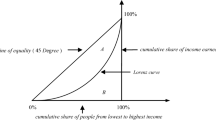Abstract
This article proposes to use an information theory approach to design a fuzzy unidimensional poverty index. In order to avoid the usual binary definition of poverty, a fuzzy set approach has been used. The total population is partitioned into three mutually exclusive groups around the poverty line. This builds on fuzzy set theory whereby the definition of the threshold of who is poor or non-poor is fuzzy. This article proposes a method using a membership function and a confidence interval of poverty line to identify to what extent households can be considered as poor or non-poor. According to this membership function, a relative entropy measure is adopted to assess an aggregation method of fuzzy individual poverty. An application using individual well-being data from Tunisian households is presented.
Similar content being viewed by others
References
Berenger V, Verdier-Chouchane A (2007) Multidimensional measures of well-being: standard of living and quality of life across countries. World Dev 35: 1259–1276
Betti G, Verma V (2008) Fuzzy measures of the incidence of relative poverty and deprivation: a multi-dimensional perspective. Stat Methods Appl 12: 225–250
Betti G, Cheli B, Cambini R (2004) A statistical model for the dynamics between two fuzzy states, theory and application to poverty analysis. Metron 62: 391–411
Bourguignon F, Chakravarty SR (2003) The measurement of multidimensional poverty. J Econ Inequal 1: 25–49
Cerioli A, Zani S (1990) A fuzzy approach to the measurement of poverty. In: Dagum C, Zenga M (eds) Income and wealth distribution, inequality and poverty, studies in contemporary, economics. Spinger, Berlin, pp 272–284
Chakravarty S (2006) An axiomatic approach to multidimensional poverty measurement via fuzzy sets. In: Betti G, Lemmi A (eds) Fuzzy set approach to multidimensional poverty measurement, Chap 3. Springer, Berlin, pp 49–72
Cheli B, Lemmi A (1995) Totally fuzzy and relative approach to the multidimensional analysis of poverty. Econ Notes 24: 115–134
Chiappero Martinetti E (2000) A multidimensional assessment of well-being based on Sen’s functioning approach. Riv Int Sci Soc 108: 207–239
Chiappero Martinetti E (2006) Capability approach and fuzzy set theory: description, aggregation and inference issues. In: Lemmi A, Betti G (eds) Fuzzy set approach to multidimensional poverty measurement. Springer, New York, pp 139–153
Cover T, Thomas J (2003) Elements of information theory. Tsinghua University Press, Beijing
Cowell FA (1977) Measuring inequality. Phillip Allan, Oxford
Cowell FA, Kuga K (1981) Additivity and the entropy concept: An axiomatic approach to inequality measurement. J Econ Theory 25: 131–143
Cowell FA, Kuga K (1981) Inequality measurement: an axiomatic approach. Eur Econ Rev 15: 287–305
Dagum C, Gambassi R, Lemmi A (1992) New approaches to the measurement of poverty. In: Poverty measurement for economics in transition. Polish Statistical Association & Central Statistical Office, Warsaw, pp 201–226
Deutsch J, Silber J (2005) Measuring multidimensional poverty: an empirical comparison of various approaches. Rev Income Wealth 51: 145–174
Dubois D, Prade H (1980) Fuzzy sets and systems. Academic Press, Boston
Kaufmann A, Gupta MM (1991) Introduction to fuzzy arithmetic. International Thomson Computer Press, London
Maasoumi E (1986) The measurement and decomposition of multidimensional inequality. Econometrica 54(4): 991–997
Ragin CC (2000) Fuzzy set social science. The University of Chicago Press, Chicago
Ravallion M (1994) Poverty comparisons. Fundamentals of Pure and Applied Economics Series. Harwood Academic Press, New York
Ravallion M, Bidani B (1994) How robust is a poverty profile? World Bank Econ Rev
Schaich E, Munnich R (1996) Der Fuzzy-Set-Ansatz in der Armutsmessung. Jahrb Nat okonomie Stat 215: 444–469
Shannon CE (1948) A mathematical theory of communication. Bell Syst Tech J 27: 379–423
Shorrocks AF, Subramanian S (1994) Fuzzy poverty indices. University of Essex, Mimeo
Theil H (1967) Economics and information theory. Rand McNally and Company, Chicago
Tsui KY (2002) Multidimensional poverty indices. Soc Choice Welf 19(1): 69–93
Tunisian Institute of Statistics (1990) Enquête sur le budget et la consommation des ménages en Tunisie. Ministère du plan, Tunis
Watts HW (1967) The iso-prop index: an approach to the determination of differential poverty income thresholds. J Hum Resour 2: 3–18
Zheng B (1997) Aggregate poverty measures. J Econ Surv 11: 123–162
Author information
Authors and Affiliations
Corresponding author
Rights and permissions
About this article
Cite this article
Belhadj, B. A new fuzzy unidimensional poverty index from an information theory perspective. Empir Econ 40, 687–704 (2011). https://doi.org/10.1007/s00181-010-0368-5
Received:
Accepted:
Published:
Issue Date:
DOI: https://doi.org/10.1007/s00181-010-0368-5




